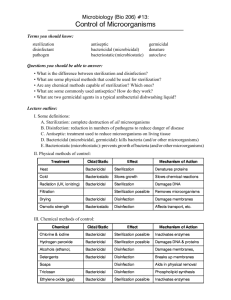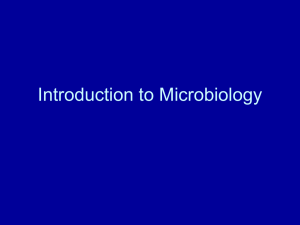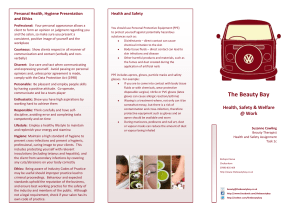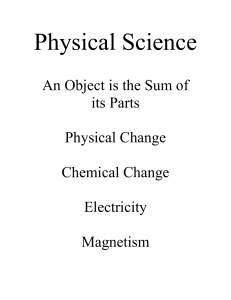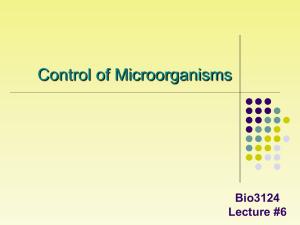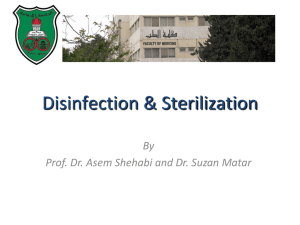Exam 2 - Faculty Web Pages
advertisement
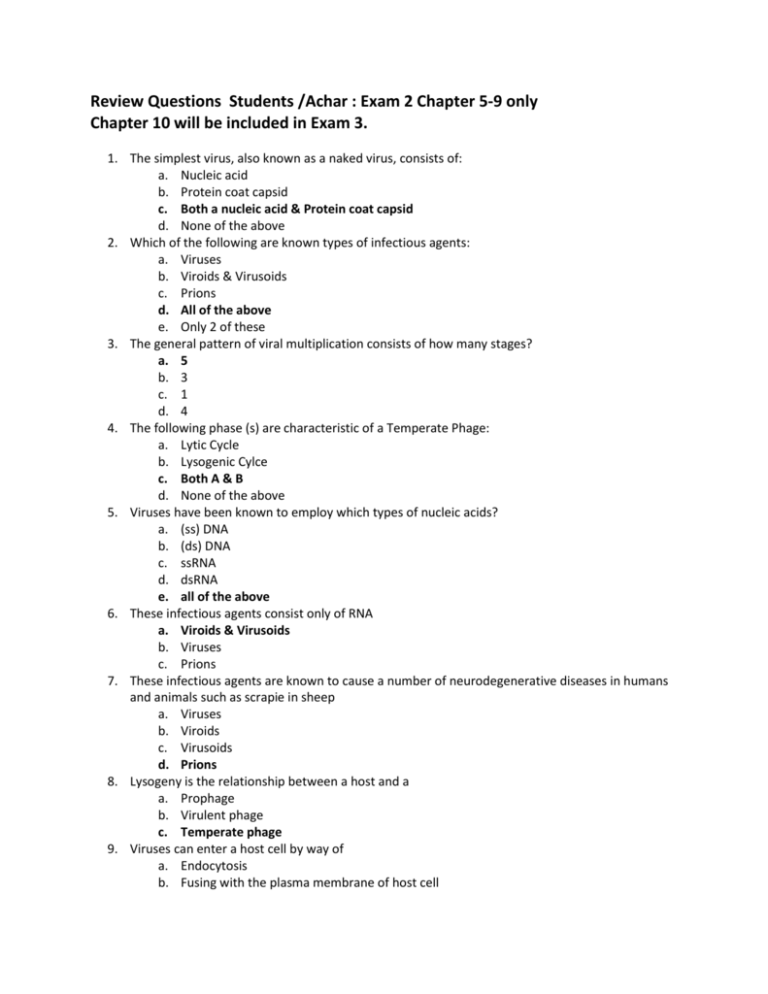
Review Questions Students /Achar : Exam 2 Chapter 5-9 only Chapter 10 will be included in Exam 3. 1. The simplest virus, also known as a naked virus, consists of: a. Nucleic acid b. Protein coat capsid c. Both a nucleic acid & Protein coat capsid d. None of the above 2. Which of the following are known types of infectious agents: a. Viruses b. Viroids & Virusoids c. Prions d. All of the above e. Only 2 of these 3. The general pattern of viral multiplication consists of how many stages? a. 5 b. 3 c. 1 d. 4 4. The following phase (s) are characteristic of a Temperate Phage: a. Lytic Cycle b. Lysogenic Cylce c. Both A & B d. None of the above 5. Viruses have been known to employ which types of nucleic acids? a. (ss) DNA b. (ds) DNA c. ssRNA d. dsRNA e. all of the above 6. These infectious agents consist only of RNA a. Viroids & Virusoids b. Viruses c. Prions 7. These infectious agents are known to cause a number of neurodegenerative diseases in humans and animals such as scrapie in sheep a. Viruses b. Viroids c. Virusoids d. Prions 8. Lysogeny is the relationship between a host and a a. Prophage b. Virulent phage c. Temperate phage 9. Viruses can enter a host cell by way of a. Endocytosis b. Fusing with the plasma membrane of host cell c. Both A & B d. None of the above 10. A member of a group of viruses with RNA genomes that carry the enzyme reverse transcriptase and form a DNA copy of their genome during their reproductive cycle is called a. Provirus b. Retrovirus c. Naked virus d. Enveloped virus 11. Pure cultures are usually obtained by isolating individual cells using what plating technique? a. b. c. d. Streak-plate Spread-plate Pour-plate All of the above 12. Which technique(s) uses an inoculating loop to spread cells across an agar surface? a. b. c. d. Streak-plate Spread-plate Pour-plate All of the above 13. Due to larger amounts of required resources, colonies usually grow most rapidly ...... a. b. c. d. in the center of an agar at the edge of an agar all over the agar None of the above 14. All organisms need which of the following nutrients to survive. A. Carbon B. Sulfur C. Antimony D. Electron source E. Both A and D are correct 15. Which statement is true about a photolithoautotroph? A. They get carbon from organic materials and energy from light B. They get carbon from organic materials and energy from inorganic chemicals C. They get carbon from CO2 and energy from light D. They get carbon from CO2 and energy from inorganic chemicals 16. Microorganisms can get nitrogen from which of the following? a. organic molecules b. c. d. e. Nitrogen in ammonia nitrate via nitrate reduction to ammonia (phototrophs and Chemotrophs) nitrogen gas via nitrogen fixation All of the above 17. Cells are recovering from transfer, may be synthesizing new components, adapting to new environment, etc. a. Stationary phase b. Death phase c. Log phase d. Lag phase 18. Cells start growing and divide at the maximum rate that is genetically possible. a. Stationary phase b. Death phase c. Log phase d. Lag phase 19. Cells are either dividing and dying at the same rate or the cells have stopped dividing, but remain metabolically active. a. Stationary phase b. Death phase c. Log phase d. Lag phase 20. Cells are dying more than they are dividing. a. Stationary phase b. Death phase c. Log phase d. Lag phase 21. During which phase do they microorganisms grow and divide at the maximum rate possible? A=log phase 22. (T/F) A thermophile has optimum growth between 80 and 113 degrees Celsius. A=F 23. Staphylococcus aureus and Saccharomyces rouxii are representative organisms of what type of microorganisms? A=osmotolerant 24. (T/F) Generation times vary markedly with the species of microorgansims and environmentla conditions. A=T 25. Which of the following is the best definition of generation time? a. The length of time it takes for lag phase. b. The length of time it takes for a population of cells to double. c. The maximum rate of doubling divided by the initial count. d. The duration of log phase. e. The time it takes for nuclear division. 26. An experiment began with 4 cells and ended with 128 cells. How many generations did the cells go through? a. 64 b. 32 c. 6 d. 5 e. 4 27. A culture of bacteria produces 5 generations in 2 hours. What is the generation time for this bacterium under those conditions? a. 15 minutes b. 24 minutes c. 30 minutes d. 0.75 hours e. l hour 28. What is the site where chromosomes replicate called? a. Cytokinesis b. Origin of reproduction c. Origin of replication d. Metaphase 29. As turbidity increases, _______ light is scattered and the absorbance reading _________. a. more; increases b. more; decreases c. less; increases d. less; decreases 30. On a temperature dependence curve, is the temperature optimum closer to the maximum or minimum growth temperature? a. Minimum b. Maximum c. Both d. Neither 31. True or False: DNA replication and partition and cytokinesis are two pathways that function during the procaryotic cell cycle. (True) 32. What plays a role in determination of cell shape and movement of chromosomes to opposite cell poles. a. MinCD b. Protein FtsZ c. Protein MreB d. All of the above 33. During log phase, cells exhibit what kind of growth? a. Optimum b. Balanced c. Unbalanced d. Regulated 34. Typically, a batch culture pasess through four distinct statges: a. Lag Stage, Logarithmic growth, stationary, death b. Log growth, Lag stage, stationary, death c. Stationary, log growth, lag stage, death d. Death, Lag stage, log growth, stationary 35. Which of the following correlate with Exponential Phase? a. Also called log phase b. Rate of growth is constant and also called as balanced growth c. Population is most uniform in terms of chemical and physical properties during this phase d. Exponential growth- all cellular components are synthsized at constant rate e. All of the above. 36. Alcohols are bactericidal, fungicidal, and sporicidal. True or False a. Answer: False 37. The longer a population is exposed to a microbial agent, the more organisms are killed. True or False a. Answer: True 38. What Sterilization is more effective? a. Moist Heat Sterilization b. Dry Heat Sterilization c. Mixed Heat Sterilization 39. The Halogen- "Iodine" can cause problems such as allergies? T/F a. True b. False 40. Surgical masks used in hospitals and labs are an example of what physical method? a. Heat b. Radiation c. Filtration 41. Bactericides, fungicides, algaecides, and viricides are included in _______ antimicrobial agents? a. static b. cidal c. boil 42. Bacteriostatic and fungistatic are "cidal" agents? T/F a. True b. False 43. A condition that influences effectiveness of antimicrobial agent activity: a. population size b. population composition c. population color d. both a and b 44. True or False? The effectiveness of various control methods depend on many factors such as the types of microorganisms, the number of microbes, environment conditions, and time of exposure. Answer: True Matching Section: Sterilization b. disinfection c. sanitization d. antisepsis e. none of the above 45. Destruction or removal of all viable organisms from an object or habitat . Answer: a)sterilization 46. Killing, Inhibition, of or removal of pathogenic organisms that may cause disease . Answer: b) Disinfection 47. Reduction of microbial population to levels deemed safe . Answer: c) Sanitization 48. Prevention of infection or sepsis of living tissue by microorganisms using antiseptics. Answer: d) antisepsis 49. True or false: Decimal Reduction time is the time required to kill 80% of the microorganisms or spores in a sample under specified conditions. Answer: False 50. What is thermal death time? a) Shortest time needed to kill all microorganisms in a suspension at a specific temperature and under defined conditions b) time required to kill 90% microorganisms or spores in a sample at a specific temperature c) controlled heating at temperatures well below boiling d) none of the above 51. The environmental protection agency regulates disinfectants. True or False? Answer: True 52. The food and drug administration regulates agents used against humans and animals. True or False? Answer: True 53. Which is not a halogen? A Fluorine B Asatine C Bromine D Chlorine E Benzene 54. An aldehyde is a highly reactive molecule that combines with nucleic acids and proteins and inactivates them True or False 55. Heavy metals CANNOT be used as germicides True or False 56. Alcohols are used as disinfectiants and antiseptics; they are bacterialcidal, fungicidal, anfd sporicidal True or False 57. Disinfection is the substantial reduction of the total microbial population and the destruction of potential pathogens. a. True b. False 58. Pasteurization is a filtration method used to reduce the number of microbes without destroying them. a. True b. False 59. What is Sterilization? a. Destruction or removal of all viable organisms from an object or habitat. b. Killing, inhibition, or removal of pathogenic organisms that may cause disease:substantial reduction of total population. c. reduction of microbial population to levels deemed safe (based on public health standards) d. Prevention of infection or sepsis. of living tissue by microorganisms using antiseptics.
